Part 1: Overview
The Korean peninsula is located at the eastern end of Asia, between China, Siberia (now part of the Russian Federation), and the islands of Japan. Because of the complex, shifting, and historic relations between these areas, as well as relations with other places such at the United Sates in more recent times, the history of Korea has been told in many ways and is still the subject of hot debate both inside and outside the Koreas. North and South Korea have different versions of the peninsula’s history, both of which differ in detail and perspective from histories written in China, Japan, Russia, and the USA. The following sections, which attempt to outline the history in a balanced way, are based on a variety of materials, including lectures attended in a special workshop on Korean culture at Korea University in the summer of 1997.
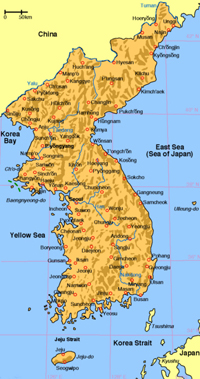
Map of Korea
The overall pattern of development in the history of the Korean peninsula is a process that begins with an unknown number of early tribal groups that populate the peninsula in prehistoric times, wandering out of Siberia and areas to the west. Over time, some of these groups form more complex societies that eventually result in early kingdoms that grow up on the peninsula; in some cases extending westwards into what is now Chinese territory. As time and events unfolded, these kingdoms were unified, though the borders and degree of unity have continued to change over time—down to today. Besides the obvious split between North and South Korea, cultural differences (including dialect, food, and local identity) exist between the various regions of the peninsula. In some cases these differences are enough to influence the results of political elections. Nevertheless, Korean culture is highly homogenous in comparison with China, and even Japan.
Over the last 2,000 years the Korean peninsula has been wracked by eight major invasions and countless smaller wars and incursions. Strategically situated on a partial land bridge in the Yellow Sea interaction sphere, the peninsula has been a natural access route for invasions to and from the Asian mainland. In times of war armies tend to push each other up and down the peninsula, guaranteeing that many areas will be subject to repeated devastation—a dynamic very prominent in the Korean War (1950-53).
Among the many invaders have been ancient Chinese kingdoms, Qidans (Khitans), Mongols, Japanese, and Manchus. In the 20th century, Korea was colonized by Japan and in the Post-WWII era was caught in the middle of conflicts between the United States, the Soviet Union, and China over the expansion of Communism in the Cold War Era – an era which still lingers in the as yet unresolved division between North and South Korea. In some cases invaders have left their mark, and even ushered in periods of positive cultural exchange, in other cases, only devastation was left in their wake. Despite these challenging circumstances, Koreans have managed to maintain a unique cultural identity that marks them as hardy survivors. Today, South Korea has among the most “wired” societies in terms of Internet access and has a dynamic economy that grew by leaps and bounds throughout the 1980s and early 1990s. South Korea has also been a leader in economic recovery after the Asian economic crisis of 1997. North Korea is poised to undergo changes within the next decades that will in part determine the stability of East Asia and the northern Pacific Rim. In short, the Korean peninsula, always integral to the dynamics of regional power and politics, will continue to play an important role on the world stage.
Part 2: Prehistory and early kingdoms
Prehistory and Myths
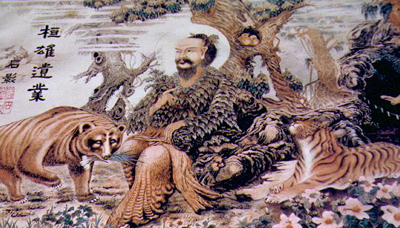
Tangun creation myth of Korea
Traditional myths of ancient Korea tell that over 4,000 years ago Hwanung, the King of Heaven, descended near a Tan tree on Mt. Taebak in North Korea. Accompanying Hwanung were 3,000 followers, and he ruled over all of their needs. In a nearby cave lived a tiger and a bear who wished to become human. As part of the test he gave them mugwort and garlic to eat, requiring them to live in darkness for 100 days. After only a few days, the tiger could no longer stand it and ran out into the mountain forests. The bear, however, stayed in the den, finally emerging as a beautiful woman. She repeatedly prayed beneath the Tan tree for a child, and Hwanung momentarily transformed himself to marry her. They produced a wonderful child they called Tangun. Tangun invented the basics of civilization and created a dynasty that lasted for 1,500 years. This was followed by a period called Kija Choson that lasted 99 years. Tangun is still regarded as a great culture-hero and his memory is marked each October 3rd on Foundation Day. Depictions of Tangun often show him with a tiger, which is regarded as a mountain god.
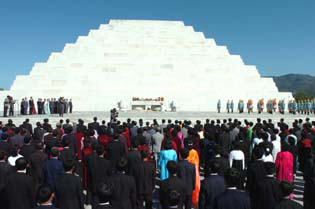
North Koreans celebrating Foundation Day, October 3rd
Archeological evidence indicates that the presence of modern humans in northeast Asia dates to 39,000 years ago. By 6,000 years BC Neolithic cultures appeared on the Korean peninsula. Early inhabitants were hunters and gatherers who migrated onto the peninsula from the Manchurian Plateau and Siberia. By 1200 BC agriculture was widespread and bronze tools were in use. Towns were protected by earthen fortifications and society became increasingly stratified. By 400 BC Chinese records tell of formidable cultures on the peninsula. Among these early peoples were the Yemak and Puyo. By 108 BC, the Han Empire had set up several posts on the peninsula after battles with the Wiman Chosun kingdom. Over the next four hundred years many aspects of Chinese culture were assimilated into the various peninsula cultures. As time went on, small kingdoms grew and sometimes confederated on the peninsula. Some had closer relations to China than others, which served to their advantage if conflicts broke out with other kingdoms.
The Three Kingdoms
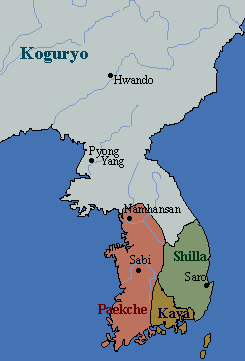
Map of the Three Kingdoms Period
With the decline and fall of the Han dynasty in China, the Chinese command posts were gradually abandoned and three major kingdoms emerged on the peninsula. These three rival kingdoms were:
Koguryo (37 BC-668 AD), located on the northern half of the peninsula, and part of what is now northeast China.
Paekche (18 BC- 660 AD), located in the southwest of the peninsula.
Shilla (Silla) (57 BC-935 AD), located on the southeast of the peninsula near present-day Kyongju.
Although the kingdoms differed in many ways and even may have spoken different languages, there were some similarities. All were agricultural economies based on rice cultivation (though other grains such as wheat and millet were also raised). Trade was mostly through barter, with a limited use of shell money or Chinese coins. Transport was by horse, oxcart, and ship.
Each of the kingdoms developed rigid social hierarchies in which a small, powerful ruling class was drawn from a small number of families. Rule was passed from father to the first born son in a system of primogeniture. The elite were ordered in the so-called “bone-rank” system (something like the idea of “blue blood” in feudal Europe). According to one’s “bones” (i.e. lineage), a person could rule as king (an option limited to very few), serve on governing councils, or hold government positions at varying levels in the provinces, counties, and smaller units of government throughout the realms. There were also numbered grades (called “head ranks”) of lower aristocracy (6, 5, 4), and free citizens (3, 2, 1), as well as lower classes that included slaves and criminals. Movement between classes was strictly controlled. A hierarchical system was also used in the military organizations, led by the king.
Each kingdom developed effective military forces of cavalry and foot soldiers employing weapons that included iron swords and spears, as well as bows and arrows. All grew up under the influence of Chinese culture. Archaeological evidence in the form of glass objects and animal designs on jewelry suggest contact with other cultural forces from farther west on the Asian landmass.
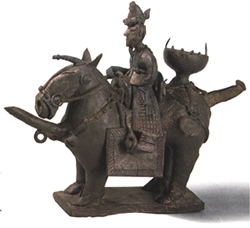
A famous example of Shilla ceramics
Buddhism was adopted by the northern state of Koguryo in 372 AD and in Paekche in 384 AD. Shilla, on the more remote eastern end of the peninsula did not adopt Buddhism as a state religion until 528 AD. One reason that Buddhism was so quickly accepted in some areas may have to do with its reinforcement of social roles (decided by actions in past lives), and thus its use in maintaining the status quo. If people accepted their lot in life, they were easier to control. Confucianism and Daoism were other aspects of worldview that gradually penetrated all three kingdoms.
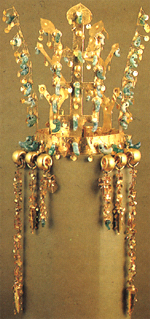
Shilla Crown
Buddhism heavily influenced the art of the kingdoms, especially in terms of temple architecture (that used native stone and wood), sculpture, and tomb paintings. In Shilla, a type of gray, ash-glazed ceramic was developed. Shilla rulers also wore intricate crowns made of thin sheets of gold that incorporated symbols of celestial trees and deer antlers. Education of the upper-classes included foreign language studies in Sanskrit and Chinese in order to better read the Buddhist sutras and Confucian classics.
In Shilla a special cadre of talented young men were cultivated in civil and martial arts, and inculcated with the time-honored values of chivalry, patriotism, harmony, and unity. These young men (something like West Point cadets) were known as the “Flower Youth Corps” (Hwarangdo). Kogruyo had a similar youth organization.
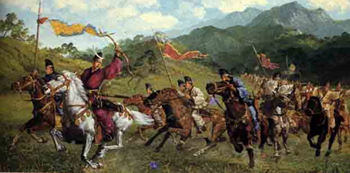
Flower Youth Corps
In general, China was regarded as a cultural model and tributary relations existed with all three states. There were also relations between some of the kingdoms and Kaya, a small league of states at the tip of the peninsula that had close relations with the Yamato culture in southern Japan. In the course of the Three Kingdoms era, there was almost constant fighting between the rival kingdoms and the borders shifted many times. The first Korean history of the Three Kingdoms era was written by Kim Pushik many centuries later in 1145 AD.
Part 3: Unified Shilla and Koryo Dynasties
Unified Shilla Period (668 - 935 AD)
Although Koguryo was the earliest, largest, and most powerful of the Three Kingdoms, by the seventh century it was suffering from a decline in leadership and was weakened by wars with Sui dynasty China. For sixteen years, a tremendous amount of resources had been used in constructing a long wall between Koguryo and China. Shilla, on the other hand, was modernizing its government and eventually strengthened its relations with the newly established Tang dynasty, though the process involved a complex series of alliances and broken alliances among the various states of the region. Eventually, Shilla was able to defeat both Paekche and Koguryo in a series of wars and take control of much of the peninsula – setting up a unified state comprised of large portions of the former Three Kingdoms. By this time the Shilla state closely followed the structure of the Chinese government, with a powerful ruler who over saw six bureaus filled with officials who over saw the affairs of the state, which included war, finance, and public works. The Unified Shilla era became a time of relative peace, prosperity, and cultural growth. Today, a great number of archaeological sites and artifacts from the period can be found in the former Shilla capital of Kyongju in the east of the peninsula.
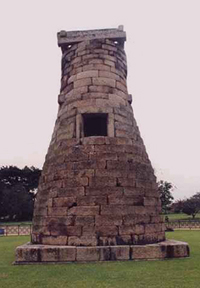
Queen's Astronomical observatory
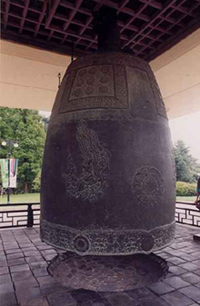
Emillie Bell
These include the Shilla tombs, burial mounds of the ancient Shilla royalty. A number have been excavated in Tumuli Park and have revealed a wealth of information on Shilla culture. Although the custom of burying living servants with the rulers was abolished in 502 AD, numerous and lavish grave goods – jewelry, everyday use items, and weapons – accompanied the dead. Another famous site is the Queen’s Astronomical Observatory (Ch’omsongdae), the oldest observatory in East Asia. It was built about 647 by a Korean queen. The structure is 9.4 meters in height and has 27 layers of cut stone – all arranged in accord to precise mathematical calculations that relate to the heavens. In the National Museum (which houses many treasures from Korean history), there is the so-called Emillie Bell. Dating to 770 AD, the bell was cast in bronze with funds collected by Buddhist monks. According to the tale, the bell would not ring clearly when first cast. A human sacrifice was deemed necessary. As the story goes, an infant farm girl was volunteered for the honor and cast into the molten metal. When the bell was recast, it rang with an “emillie” sound, like a cry of a child for its mother.
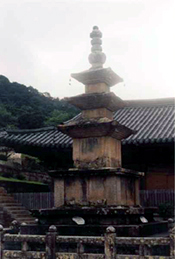
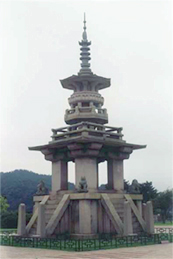
Sokkat'ap and Tabot'ap Pagoda
In the nearby mountains is a great granite and wood temple known as Pulguksa, meaning “Temple of the Buddha Land.” Dating to the early 6th century, it has been re-constructed several times after periods of warfare. The temple is the finest example of Shilla-style temple architecture in existence. In the main courtyard are two small pagodas known as Sokkat’ap Pagoda and Tabot’ap Pagoda. According to the story, a newly-wed stoneworker was commissioned to carve the two pagodas. His work took him far from home for several years. One night he had a dream that his wife was standing by a pond near Pulguksa, awaiting his return. Little did he know that his dear, young wife had actually made the long journey to the temple site, and was indeed waiting for him outside. After several days, however, she had not caught even a glimpse of her busy husband. Several locals told her to look at the reflection of the pagodas in the pond. She did so, but still did not see her husband. Believing she would never see him again, she jumped in and drowned. Later, when her husband heard of her death, he ran about the pond and forests, searching for her in vain. He finally found a human-shaped rock and carved a Buddha upon it in remembrance of his wife.
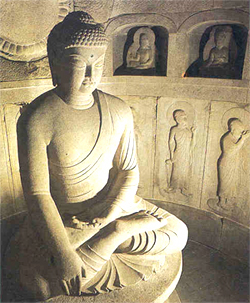
Granite Buddha in Sokkuram Grotto Shrine
One of the most outstanding architectural and artistic feats of the Unified Shilla period is the Sokkuram Grotto Shrine, located in a mountain cave not far from Pulguksa Temple. Dating to 751 AD, the grotto was eventually lost, and for centuries lay undisturbed. In 1909, the grotto was re-discovered when a mail courier took refuge from the rain. The central sculpture is a sublime carving of Sakyamuni Buddha executed in white granite. The massive carving, crafted from a single piece of stone, commands the interior of an arched vault and measures seven meters in diameter. The vault is constructed of intricately shaped, interlocking slabs of granite. The domed walls are lined with carvings of Buddhist deities, including the Four Heavenly Kings and an array of bodhisattvas and disciples. The site is a testament to the high level of mathematics, astronomy, architectural principles, and artistry of the Unified Shilla period in East Asia during a time when powerful cultural influences were traversing the Silk Road.
Although Shilla unified and controlled most of the peninsula, another state eventually formed in parts of the former Koguryo kingdom to the north. This kingdom, also ruled on the Chinese model, was known as Parhae and was situated between northeast China (what came to be known as Manchuria) and Shilla. The Parhae kingdom was established in 716 AD and lasted until 926 AD. As the Tang dynasty declined in China, leadership in Unified Shilla was also weakening. In the course of uprisings and fighting the Unified Shilla state fell into pieces, somewhat along the lines of the old Three Kingdoms. Eventually a rebel leader named Wang Kon became strong enough to challenge Shilla. In the end, he and the last Shilla king ended it amicably by each marrying one of the other’s daughters, with Wang taking control and allotting the former king a large holding of land. The new state would be known as the Koryo dynasty.
Koryo Dynasty (918 - 1392 AD)
The Koryo dynasty, founded by Wang Kon, extended the borders of the defeated Unified Shilla northwards into parts of old Koguryo – Koryo is a shortened form of that name. The name “Korea” is derived from Koryo. In his bid to maintain control over the new kingdom, Wang Kon followed an old Chinese strategy (also used in Tokugawa Japan) of forcing local rulers to send male members of their families (often sons) to live in the capital as virtual hostages. He also took 29 consorts from families of position all over the realm. Although this initially helped him gain control, in the long run succession problems arose because of the many powerful families involved.
In the Koryo period, the government became even more complex and centralized than in Unified Shilla. The Chinese model was followed even more closely— civil service examinations were established, and open to all except the lowliest classes. Special considerations were made, however, for sons from the higher ranks of society, who could be given positions by appointment. Examinations were based on composition, knowledge of the Confucian Classics, and occupational knowledge such as astronomy, mathematics, and law. A national academy was established as well as private institutions of learning. Although in theory there was no private ownership of land, land tracts were often given to high office holders and military personnel. Taxes were levied on landholdings and households and the government could demand yearly service for labor projects. Individual regions, which specialized in certain products, might also be asked to supply quotas of these goods. The government also ran production industries (manufactories) staffed by artists and craftsmen in the capital and provinces – some in the provinces staffed were by persons in the lowest social classes. Products ranged from consumer goods, such as precious metals (gold and silver), salt, silk, charcoal, paper, ink, and roof tiles, to agricultural items such as fruits, grain, sesame, and ginger.
Although the bone-rank system of Shilla had been broken by the rising of powerful new families and leaders in the rebellion drawn from lower classes, hierarchy was still a powerful social concept. The new classes that emerged in Koryo fell into six ranks in the following order of importance: 1) the royal caste group, comprised of relations to the royal clan; 2) a class of civil and military officials known as the yangban ("two classes"); 3) palace functionaries of lower official rank; 4) regional clerks and other lower government officials; 5) tax-paying free citizens, mostly peasant farmers, fishermen, artisans, etc.; 6) inferior, stigmatized people such as butchers and market hunters (who were defiled under Buddhism by taking life), itinerant peddlers, the female entertainers known as kisaeng, and slaves. Landholdings were held mostly by the upper and middle ranks.
During the Koryo period Buddhism flourished and was closely linked to the ruling caste. The period was also a time of change on the northern borders, as Parhae was overrun by the newly emerging Liao (Qidan) state in what is now northeast China (and many refugees fled to Koryo). Koryo was eventually invaded twice by the Liao, as well as briefly by the Song dynasty in China, which soon came under the control of successors to the Liao – the Jin, who conquered northern China, and were eventually conquered in turn by the Mongols. By 1231, the Mongols had begun serious incursions into Koryo that lasted thirty years with devastating effect. In some cases the Koryo forces put up stiff resistance, including the month-long siege of Kuju, in which the Mongols employed a whole array of ”weapons of mass destruction”:
… The siege saw a full array of medieval assault weapons used in the many attempts to take the city. Lines of catapults hurled boulders or molten metal at the city, tunneling efforts to undermine the walls were made, siege towers and scaling ladders were used in assaults, fire carts were rolled against the wooden city gates, and fire-bombs of human fat – made by boiling down captives—which were practically inextinguishable, were used. (Henthorn 1971:118)
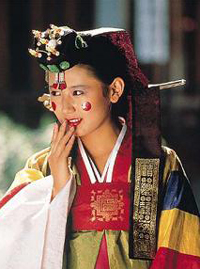
Korean bride
Though resistance continued, relations eventually improved between the Mongol and the Koryo court. This was due in part to the personal relationship between the Koryo King Wonjung and Khubilai Khan. According to the story (an example of contemporary diplomacy), when the Khan developed gout in his feet, King Wonjung sent him a pair of orthopedic shoes made of fish skin. In turn, when the King was ill, the Khan sent a special medicinal soup. Both Mongol and Korean brides were traded in alliances that deepened over the years, with a Korean lady actually serving as the final empress in the Yuan dynasty in China. During the latter Koryo period Mongol cultural influences left a lasting impression on Korean culture (some say that the red circles on a traditional Korean bride’s face today are related to the Mongol legacy).
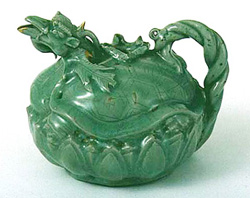
Koryo celadon
Among the artistic and technical accomplishments of Koryo was the creation of a sublime style of ceramic known as Koryo celadon. The greenish-blue hue of the glaze was especially coveted by Song dynasty Chinese emperors (who also enjoyed Chinese celadons). Unfortunately, the formula for the hue was lost in the Mongol invasions and never recovered, despite attempts that continue today.
Printing technology also advanced during the era. During the Mongol invasion the wooden printing blocks used to print the Buddhist scriptures were burned. As a result, the monks on Kanghwa Island re-carved them—all 80,000—and carried them on their heads into the southern mountains. The blocks (known as the Tripitak Koreana, or Pal-man-dae-jang-gyung) are still housed today in the Haeinsa Temple on Mt. Kaya.

80,000 wooden printing blocks
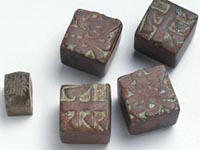
Metal type
Another result of the burning of the Buddhist printing blocks was the invention of moveable metal type. Although both the Chinese and Koreans had been experimenting with printing for centuries, and moveable ceramic type was in limited use, the Koreans developed moveable cast bronze type as another way to try and preserve the scriptures. Thereafter, both metal type and woodblock printing techniques were used down to modern times, when they were largely displaced by Western moveable type in the early 20th century. Despite advances in printing, brush writing was still the most common form of written communication at the individual level. One of the most popular literary forms was a style of lyric poetry, sometimes used for social comment, known as sijo poetry. Popular folk songs were known as changga and were often of a humorous, earthy flavor.
Such poetry would become even more popular in the dynasty that succeeded Koryo – the Yi or Chosun dynasty that arose during the waning of Mongol power and the rise of the Ming dynasty in China. Powerful families that had supported the Mongols were eventually swept from power and Buddhist hold on the government was ended as a new generation of leadership under General Yi Songye established the longest—and last—dynasty in Korean history.
Part 4: The Last Dynasty
Choson (Yi) Dynasty (1392-1910 AD)
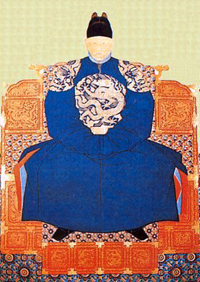
Yi Songye
The Choson, or Yi, dynasty lasted from 1392 until 1910. In the course of the dynasty, relations were established with Ming China; the peninsula was invaded by the Japanese in the late 16th century; their neighbors, the mighty Manchus, invaded a few decades later; Western powers threatened Korea by the mid-19th century, while Japan positioned to take control of Korea by the end of that century, which finally prompted the fall of Choson in 1910. Thus, the longest dynasty in Korea’s history spans some of the most transitional periods in the recent history of East Asia.
As noted, General Yi Songgye founded the dynasty which took his name. Yi had made a name for himself fighting Jurched forces in Manchuria and Japanese pirates (wako) on the seas around the peninsula. As Koryo fell apart under a series of child rulers and shifting alliances among the forces in northeast Asia, Yi took control of the situation on the peninsula and set up the Yi or Choson dynasty. To secure power he stripped former powerful families of landholdings and withdrew government support of Buddhist monasteries. Some sources say it took days to burn the land registers in the streets of the new capital at Seoul. The last Koryo king was exiled and faithful officials purged from the government or even executed.
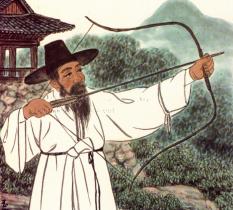
A yangban practicing archery
A strong central bureaucracy was established, building on the Chinese/Koryo model, but extending government control over the realm even farther. New officials were appointed from among Yi’s followers and land re-divided. Large numbers of civil officials and military, appointed through a rigorous series of civil service or military examinations, came to fill the ranks of the yangban. As time went on, the civil service yangban became a leisured class with elite tastes whose members excelled in the arts of painting, calligraphy, and writing classical Chinese and the more vernacular sijo poetry. As the power of the Buddhist organizations was weakened, Confucianism was promoted and elaborated under the tenets of Neo-Confucianism. In the early decades of Choson, reforms in agricultural and economic reforms were carried out, printing with metal type increased (including texts exported to Japan), paper money was issued, and schools and academies prospered. Books were published on Neo-Confucianism, literature, agriculture, technology, and medicine. In terms of social control, one ruler even instituted the use of identity tags (made of ivory, antler, or wood, depending on class) to keep track of all males for tax and other purposes.
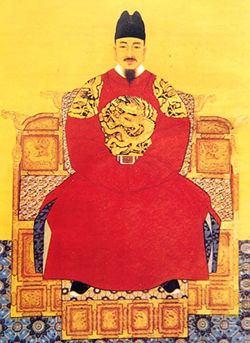
The Great King Yi Sejong
The vibrant new dynasty produced outstanding rulers and scholars. Among them was the almost incomparable King Sejong, the fourth Choson monarch who reigned from 1418-1450. Known as a model king, Sejong surrounded himself with the finest scholars of the day and commissioned important research projects, including astronomy, geography, firearms and metals technology, and irrigation. Probably the most enduring project was the creation of the Hangul syllabary. Often regarded as the most scientific syllabary ever invented, the shapes of the symbols are based on abstract representations of the mouth and tongue when pronouncing the various basic sounds. Although Korean scholars continued to use written Chinese characters down into the early twentieth century, Hangul became popular among merchants, women, and authors of popular fiction, as it was easy for people to learn. Many translations of Chinese Confucian and Buddhist classics were made into the new system of writing.
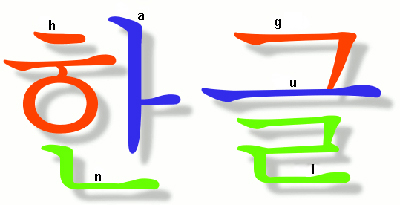
The word "Hangul" in Hangul
Neo-Confucianism, developed by the Song philosopher Zhu Xi, became popular in the Choson period. Of great interest was the relation between moral principles (“I” in Korean, “li” in Chinese) and the vital life force known as qi in Chinese and ki in Korean. The most famous Korean exponent of living in accord with innate moral principles was Yi Hwang (1501-1570), also known by his literary name, T’oegye. Leaving a lower official position in the capital, he set up a small academy called Tosansowon (Peach Mountain Academy) in the Andong region in the southeast. Scholars and students came to the academy to study with Yi Hwang, who welcomed even the local children. On a low veranda surrounded by various plants and a small pool, Yi Hwang spoke with the children about the moral qualities of the cultivation of kyong – one’s basic honest nature. Using examples of plants such as pine, bamboo, and lotus, Yi Hwang explained how proper cultivation of kyong will show in one’s actions and one can rise above one’s situation like a lotus arising from the mud of a pond. As part of his daily regimen, Yi Hwang practiced throwing arrows into the thin neck of a bottle, an activity immortalized on the South Korean 1,000 won bill that depicts Yi Hwang and the arrow bottle.
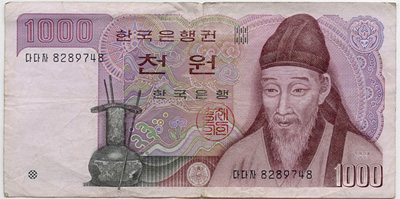
Yi Hwang and arrow bottle on South Korean 1,000 won bill
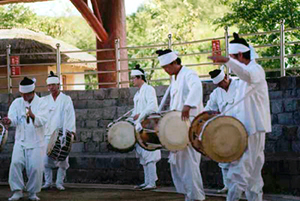
Farmer's band
Besides the growth of a refined elite culture, the folk culture of the urban lower classes and peasantry was rich—and often humorous and earthy. Local bands of percussion, wind, and string instruments accompanied farmers as they planted rice and provided music at festivals, weddings, and other events. In recent years, this so-called “farmer’s music” (nong-ak) has been the basis for a revival of folk music, including the well-known percussion group, Samulnori.
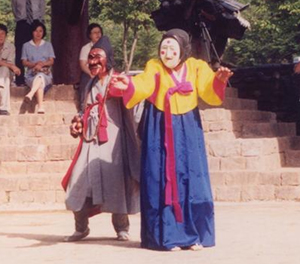
Masked dance
Masked dance dramas have a long history in East Asia and the Korean form is known as talch’um. In the Yi dynasty such dramas were often associated with festivals on the Lunar calendar, especially during slack times in the agricultural cycle. In the Andong region, village performances began with a young actor dressed as the village goddess standing on the shoulders of another actor. She would be carried around the performance space as part of a village-protection rite, which was the dual function of many performances that were held as much to entertain the gods (and thus gain their favor) as to entertain the local audiences.
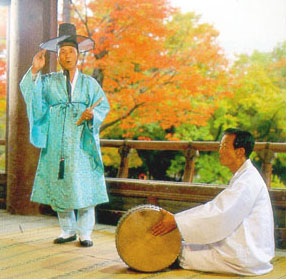
P'ansori
By the last half of the dynasty, a type of performance art that became popular was a form of storytelling that combined singing and speaking. This “one-man opera” (p’ansori) featured a single storyteller who would unroll a grass mat as a performance space and holding a folding fan would entertain audiences with long stories, the musical parts accompanied by an assistant playing an hour-glass drum (changgol). The most famous stories were about filial young women beset with barriers and indignities in the hierarchical Neo-Confucian society that placed many strictures on the behavior of women. These stories included the “Story of Chun-hyang” and the “Story of Simchong.”
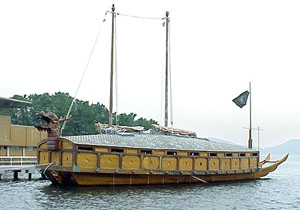
Turtle boat
By the end of the 16th century, various internal and external situations precipitated in a series of devastating invasions from which the Yi dynasty never really recovered. As royal leadership declined, struggles for power on the islands of Japan spilled over onto the Korean peninsula in a series of invasions launched by the warlord Hideyoshi. Despite fierce resistance from government troops and peasant militias—and aid from the Ming dynasty—many parts of the peninsula were sacked by Japanese troops that arrived by sea with firearms and cannon. Although the Koreans had used gunpowder since the Mongol era, a particularly galling experience was having captured Korean cannons used as cannonballs and shot back into Korean fortifications by larger bored Japanese guns. One bright point in the invasions was the armada of turtle boats commanded by Admiral Yi Soon-sin. Yi had invented a sort of armored ship holding many cannons that for a time deferred the Japanese forces. In the long run the Koreans held on as the Japanese became embroiled in the internal clashes leading to the founding of the Tokugawa shogunate.
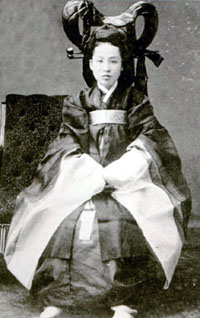
Queen Min
The Chosun dynasty barely had time to recover from Hideyoshi’s incursions, when scarcely thirty years later new invaders appeared on the northern borders in the form of the Manchus, who were establishing their empire under the leadership of Nurhaci and Abadi. As the Ming fell and the Manchu Qing dynasty arose, Korea found itself allied as a tribute state to the Manchus, after a series of devastating invasions—that were fiercely resisted, or aided, depending on what side of the internal struggles forces were on. A certain number of Korean rebels actually joined the Manchus, forming a Korean banner. Korean leadership never returned to its earlier days of glory. By the time Western forces (French, English, American, and Russian) began sending missions up Korean rivers to force the so-called “hermit kingdom” to open its doors in the latter 19th century, the most powerful ruler was Queen Min, regent to a weak young king. Queen Min played a role similar to that of the Empress Dowager Ci Xi, whose rule overlapped with her's for a few years. The Queen was killed by Japanese-backed assassins in 1895 as Japan maneuvered into place to take Korea as a colony. The Manchus vainly attempted to hold the situation together (future president of the Republic of China, Yuan Shikai was the field marshal in Korea for sometime).
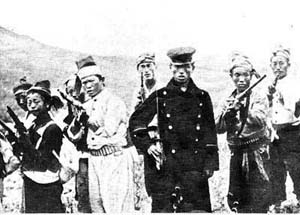
Tonghaks
Inner turmoil and rebellion ignited with the rise of an anti-foreign group called the Tonghaks, who attempted to use “Eastern Learning” (aspects of the Three Teachings, described in Module 3) to resist the challenge of the West. Although its leader, Ch’oe Cheu, was executed, social instability continued as did the decline in leadership. By 1910 Japan had taken Korea as a colony, with quiet acquiescence from the British and the United States who formed a secret pact with Japan to protect their own holdings in Asia.
Part 5: Korean History 1910 - Present
1910-1945: The dark days
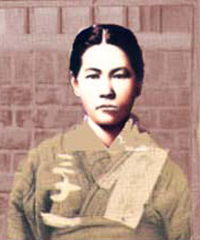
Yu Kwan-soon, the Korean "Joan of Arc"
The period between 1910 and 1945 are considered the darkest days in modern Korean history. Under the control of the imperialist empire of Japan, Korea was stripped of its natural resources (though many forests have recovered in recent years), language, media, and customs were suppressed—at one time the attempt was made to force the populace to take Japanese surnames. Resistance began in early 1919. Students and workers took to the streets in nationwide demonstrations similar to those that later began in the May Fourth Movement in China. The protests were put down with violence. Among the young patriots of the day was a 16 year-old martyr named Yu Kwan-soon, who was tortured to death in prison. She is remembered as a Korean “Joan of Arc.”
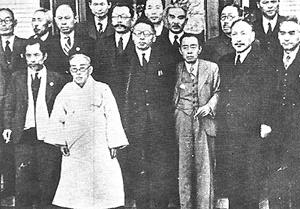
The Provisional Government of Korea established in Shanghai, China
A provisional government was set up in Shanghai, China during the 1930s under the leadership of Kim Ku. Meanwhile, General Kim Il-sung led communist resistance fighters in raids against the Japanese in the northern part of the peninsula.
Post WWII Era: Two Different Roads
Soon after the end of the Japanese empire in the summer of 1945, Korea’s fate was decided at a meeting in the eastern United States at which no Koreans were present. In a short meeting a line dividing North and South Korea was marked along the 38th parallel. The line divided the spheres of influence of the American-led Allied forces and the forces of the Soviet Union, which had been posed in Siberia in hopes of taking the Japanese surrender in East Asia. As relations between the former allies degenerated, governments in the communist North and republican South failed to reach accords over united rule. The situation deteriorated further when the Soviet Union suddenly withdrew support from the North.
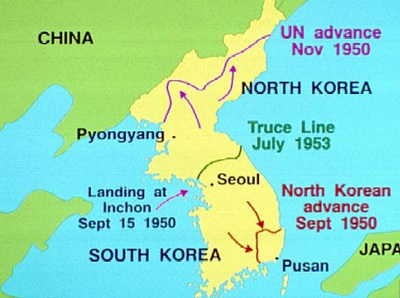
Korean War
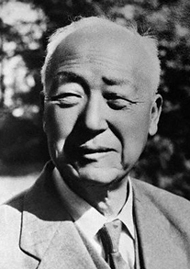
Syngman Rhee
As time passed, the economy of North Korea improved fairly rapidly under Kim Il-sung’s “self-reliance” or ju-che policy. South Korea, under the US backed Syngman Rhee, who had been a leader of the provisional government in Shanghai, gave way to a series of military dictators. The economy lagged behind that of North Korea until the late 1960s, when the economy began to improve under the iron fist of Park Chung-hee, who believed that economic growth comes first, then democracy. Growth was linked with strong government support for a handful of super-companies (like Samsung, Daewoo, LG, and Hyundai) known as chaebol.

Logos of several well-known Korean companies

Street scene in downtown Seoul, South Korea
As the economy improved throughout the 1970s and 1980s (when the South Korean economy was the fastest-growing on earth), cries for democracy arose from the people. With one of the absolute highest literacy rates in the world, the economically well-off and educated middle-class helped fuel demands for democracy. Thousands of university students became involved in protracted protests and struggles – some which were put down with violence. By the late 1980s, the military government was replaced by democratically elected leaders. Although corruption has plagued the new Korean politics, the voting rate is high and the public enthusiastically participates in election and issues-related politics.
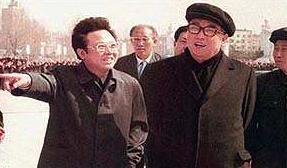
North Korean leader Kim Jong-il (left) with father, the late Kim Il-sung
As the Republic of Korea in the south blossomed during the 1980s and early 1990s, the Democratic People’s Republic of Korea in the north stagnated and turned even more inward. Economic hardship descended on the country with the collapse of the Soviet Union in 1989 and withdrawal of the economic support that had resumed from that country after the Korean War. The “Great Leader” passed away in 1994—ushering in a three-year period of mourning. His son, Kim Jung-il took command and is the present ruler.
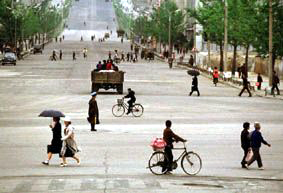
Street scene in North Korea
Concerns over nuclear capability in North Korea continue to strain relationships in northern East Asia. South Korea, China, Japan, Russia, and the United States are all involved in varying degrees in the power-equation of the region. China is a key player in problems on the Korean peninsula, as she has retained ties with North Korea (and established new ties with the South), and may eventually serve as a model to follow in economic liberalization. By 2002 several special economic zones (SEZ) similar to the experimental capitalist zones created in China in the early 1980s, were established in places like Sinuiju and Gaesung. North Korea, however, remains the most isolated nation on earth and questions on the eventual re-unification with South Korea remain to be answered.
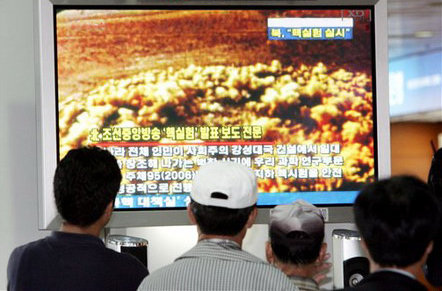
South Koreans viewing a news report of the alleged North Korean nuclear blast test (October 2006)